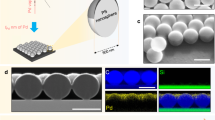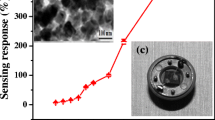Abstract
For the development of catalyst materials a novel sensor tool is presented. It can determine catalyst light-off temperatures. The device measures temperature changes (exothermicities) due to catalytic reactions of the material which is coated on a very small catalyst coating area directly on the sensor device. By temperature modulation via an integrated heater, light-off temperature characteristics can be determined within a few minutes. In the present contribution, the sensor setup is introduced and several experimental results for an exemplarily investigated Pt-loaded Al2O3 catalyst are shown with typical exhaust gas components and with mixtures of their components in a lean base gas atmosphere. Several typical findings are light-off hysteresis, CO poisoning, alkane light-off-behavior or acetylene poisoning.







Similar content being viewed by others
References
Shelef M, McCabe RW (2000) Twenty-five years after introduction of automotive catalysts: what next? Catal Today 62:35–50. doi:10.1016/S0920-5861(00)00407-7
Heck R, Farrauto R (2001) Automobile exhaust catalysts. Appl Catal A 221:443–457. doi:10.1016/S0926-860X(01)00818-3
Herreros JM, Gill SS, Lefort I, Tsolakis A, Millington P, Moss E (2014) Enhancing the low temperature oxidation performance over a Pt and a Pt–Pd diesel oxidation catalyst. Appl Catal B 147:835–841. doi:10.1016/j.apcatb.2013.10.013
Tsinoglou D, Koltsakis G, Samaras Z (2002) Evaluation of on-board diagnosis methods for three-way catalytic converters. Environ Sci Technol 23:5270–5278. doi:10.1021/es010269y
Wiegärtner S, Hagen G, Kita J, Schönauer-Kamin D, Reitmeier W, Hien M, Grass P, Moos R (2015) Thermoelectric hydrocarbon sensor in thick-film technology for on-board-diagnostics of a diesel oxidation catalyst. Sens Actua B Chem 214:234–240. doi:10.1016/j.snb.2015.02.083
Kohler H, Röber J, Link N, Bouzid I (1999) New application of tin oxide gas sensors I. Molecular identification by cyclic variation of the working temperature and numerical analysis of the signals. Sens Actua B Chem 61:163–169. doi:10.1016/s0925-4005(99)00286-5
Gramm A, Schütze A (2003) High performance vapor identification with a two sensor array using temperature cycling and pattern classification. Sens Actua B Chem 95:58–65. doi:10.1016/s0925-4005(03)00404-0
Kita J, Engelbrecht A, Schubert F, Groß A, Rettig F, Moos R (2015) Some practical points to consider with respect to thermal conductivity and electrical resistivity of ceramic substrates for high-temperature gas sensors. Sens Actua B Chem 213:541–546. doi:10.1016/j.snb.2015.01.041
Burns GW, Strouse GF, Liu BM, Mangum BW (1992) Gold versus platinum thermocouples: performance data and an ITS-90 based reference function. Temp Meas Control Sci Ind 5:531–536
Beulertz G, Votsmeier M, Moos R (2015) Effect of propene, propane, and methane on conversion and oxidation state of three-way catalysts: a microwave cavity perturbation study. Appl Catal B 165:369–377. doi:10.1016/j.apcatb.2014.09.068
Koutoufaris I, Koltsakis G (2014) Heat-and mass-transfer induced hysteresis effects during catalyst light-off testing. Can J Chem Eng 92:1561–1569. doi:10.1002/cjce.22011
Etheridge JE, Watling TC (2015) Is reactor light-off data sufficiently discriminating between kinetic parameters to be used for developing kinetic models of automotive exhaust aftertreatment catalysts? the effect of hysteresis induced by strong self inhibition. Chem Eng J 264:376–388. doi:10.1016/j.cej.2014.11.089
Bowker M (2008) Automotive catalysis studied by surface science. Chem Soc Rev 37:2204–2211. doi:10.1039/B719206C
Nishibori M, Shin W, Tajima K, Houlet L, Izu N, Itoh T, Tsubota S, Matsubara I (2007) Thermoelectric gas sensor using au loaded titania CO oxidation catalyst. J Ceram Soc Jpn 115:37–41. doi:10.2109/jcersj.115.37
Moos R, Wedemann M, Spörl M, Reiß S, Fischerauer G (2009) Direct catalyst monitoring by electrical means: an overview on promising novel principles. Top Catal 52:2035–2040. doi:10.1007/s11244-009-9399-6
Reiß S, Wedemann M, Moos R, Rösch M (2009) Electrical in-situ characterization of three-way catalyst coatings. Top Catal 52:1898–1902. doi:10.1007/s11244-009-9366-2
Moos R (2010) Catalysts as sensors—a promising novel approach in automotive exhaust gas aftertreatment. Sensors 10:6773–6787. doi:10.3390/s100706773
Author information
Authors and Affiliations
Corresponding author
Rights and permissions
About this article
Cite this article
Hagen, G., Leupold, N., Wiegärtner, S. et al. Sensor Tool for Fast Catalyst Material Characterization. Top Catal 60, 312–317 (2017). https://doi.org/10.1007/s11244-016-0617-8
Published:
Issue Date:
DOI: https://doi.org/10.1007/s11244-016-0617-8




